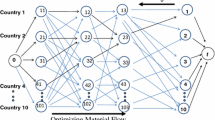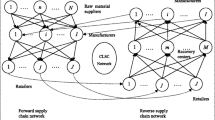Abstract
In this paper, we present a multitiered dynamic supply chain network equilibrium modeling framework in which the decision-makers have sufficient information about the future and seek to determine their optimal plans that maximize their profits over the multiperiod planning horizon. We construct the finite-dimensional variational inequality governing the equilibrium of the multiperiod competitive supply chain network. The model allows us to investigate the interplay of the heterogeneous decision-makers in the supply chain in a dynamic setting, and to compute the resultant equilibrium pattern of product outputs, transactions, inventories, and product prices. We then establish the supernetwork equivalence of the multiperiod supply chain model with a properly configured transportation network, which provides a new interpretation of the equilibrium conditions of the former in terms of paths and path flows. This framework offers great modeling flexibility so that, for example, transportation delay and/or perishable products can be easily handled, as we also demonstrate. Numerical examples are provided to illustrate how such multiperiod supply chain problems can be reformulated and solved as transportation network equilibrium problems in practice.
Similar content being viewed by others
References
Aashtiani M, Magnanti TL (1981) Equilibrium on a congested transportation network. SIAM J Algebr Discrete Methods 2:213–216
Anupindi R, Bassok Y (1996) Distribution channels, information systems and virtual centralization. In: Proceedings of the manufacturing and service operations management society conference, pp 87–92
Balkhi ZT, Benkherouf L (2004) On an inventory model for deteriorating items with stock dependent and time-varying demand rates. Comput Oper Res 31:223–240
Bazaraa MS, Sherali HD, Shetty CM (1993) Nonlinear programming: theory and algorithms. Wiley, New York
Beckmann MJ, McGuire CB, Winsten CB (1956) Studies in the economics of transportation. Yale University Press, New Haven
Bernstein F, Federgruen A (2003) Pricing and replenishment strategies in a distribution system with competing retailers. Nav Res Logist 51:409–426
Bhattacharjee S, Ramesh R (2000) A multi-period profit maximizing model for retail supply chain management: an integration of demand and supply-side mechanisms. Eur J Oper Res 122(3):584–601
Boyce DE, Mahmassani HS, Nagurney A (2005) A retrospective on Beckmann, McGuire, and Winsten’s studies in the economics of transportation. Pap Reg Sci 84:85–103
Bramel J, Simchi-Levi D (1997) The logic of logistics: theory, algorithms and applications for logistics management. Springer, New York
Cachon GP, Netessine S (2003) Game theory in supply chain analysis. In: Simchi-Levi D, Wu SD, Shen M (eds) Supply chain analysis in the ebusiness era. Kluwer, Dordrecht, pp 200–233
Cachon GP, Zipkin PH (1999) Competitive and cooperative inventory policies in a two-stage supply chain. Manag Sci 45:936–953
Chopra S, Meindl P (2009) Supply chain management: strategy, planning, and operations, 4th edn. Prentice Hall, New York
Cojocaru MG, Daniele P, Nagurney A (2005) Projected dynamical systems and evolutionary variational inequalities via Hilbert spaces with applications. J Optim Theory Appl 127(3):549–563
Cojocaru MG, Daniele P, Nagurney A (2006) Double-layered dynamics: a unified theory of projected dynamical systems and evolutionary variational inequalities. Eur J Oper Res 175(1):494–507
Corbett CJ, Karmarkar US (2001) Competition and structure in serial supply chains with deterministic demand. Manag Sci 47:966–978
Coyle JJ, Langley CJ, Gibson B, Novack RA, Bardi E (2008) Supply chain management: a logistics perspective, 8th edn. South-Western Cengage Learning, Mason
Cruz JM (2008) Dynamics of supply chain networks with corporate social responsibility through integrated environmental decision-making. Eur J Oper Res 184(3):1005–1031
Cruz JM, Wakolbinger T (2008) Multiperiod effects of corporate social responsibility on supply chain networks, transaction costs, emissions, and risk. Int J Prod Econ 116:61–74
Dafermos S (1982) The general multimodal network equilibrium problem with elastic demand. Networks 12:57–72
Dafermos S (1996) Isomorphic multiclass spatial price and multimodal traffic network equilibrium models. Reg Sci Urban Econ 16:197–209
Dafermos S, Nagurney A (1984a) Sensitivity analysis for the general spatial economic equilibrium problem. Oper Res 32:1069–1086
Dafermos S, Nagurney A (1984b) Stability and sensitivity analysis for the general network equilibrium—travel choice model. In: Volmuller J, Hamerslag R (eds) Proceedings of the ninth international symposium on transportation and traffic theory. VNU Science Press, Utrecht, pp 217–232
Dafermos S, Nagurney A (1985) Isomorphism between spatial price and traffic network equilibrium problems. In: LCDS # 85-17, Lefschetz center for dynamical systems. Brown University, Providence
Dafermos S, Nagurney A (1987) Oligopolistic and competitive behavior of spatially separated markets. Reg Sci Urban Econ 17:245–254
Dafermos S, Sparrow FT (1969) The traffic assignment problem for a general network. J Res Natl Bur Stand B, Math Math Phys 73B:91–118
Daniele P (2006) Dynamic networks and evolutionary variational inequalities. Edward Elgar, Cheltenham
Demirtas EA, Ustuna O (2009) Analytic network process and multi-period goal programming integration in purchasing decisions. Comput Ind Eng 56(2):677–690
Dogan K, Goetschalckx M (1999) A primal decomposition method for the integrated design of multi-period production-distribution systems. IIE Trans 31(11):1027–1036
Federgruen A (1993) Centralized planning models for multi-echelon inventory systems under uncertainty. In: Graves SC, Rinooy Kan AHG, Zipkin P (eds) Handbook in operations research and management science: volume on logistics of production and inventory. Elsevier, Amsterdam, pp 133–137
Federgruen A, Zipkin P (1986) An inventory model with limited production capacity and uncertain demands I: the average cost criterion. Math Oper Res 11:193–207
Fisher M, Ramdas K, Zhen Y-S (2001) Ending inventory valuation in multiperiod production scheduling. Manag Sci 47(5):679–692
Fisk C, Boyce DE (1983) Alternative variational inequality formulation of the network equilibrium-travel choice problem. Transp Sci 17:454–463
Florian M, Hearn D (1995) Network equilibrium models and algorithms. In: Ball MO, Magnanti TL, Monma CL, Nemhauser GL (eds) Network routing, handbooks in operations research and management science, vol 8. Elsevier Science, Amsterdam, pp 485–540
Florian M, Klein M (1971) Deterministic production planning with concave costs and capacity constraints. Manag Sci 18(1):12–20
Friesz TL, Rigdon MA, Mookherjee R (2006) Differential variational inequalities and shipper dynamic oligopolistic network competition. Transp Res, Part B, Methodol 40(6):480–503
Gabay D, Moulin H (1980) On the uniqueness and stability of Nash equilibria in noncooperative games. In: Bensoussan A, Kleindorfer P, Tapiero CS (eds) Applied stochastic control in econometrics and management science. North-Holland, Amsterdam, pp 271–294
Ganeshan R, Jack E, Magazine MJ, Stephens P (1998) A taxonomic review of supply chain management research. In: Tayur S, Magazine M, Ganeshan R (eds) Quantitative models for supply chain management. Kluwer Academic, Boston, pp 531–574
Gartner NH (1980) Optimal traffic assignment with elastic demands, a review; part II: algorithmic approaches. Transp Sci 14:192–209
Geunes J, Pardalos PM (2003) Network optimization in supply chain management and financial engineering: an annotated bibliography. Networks 42:66–84
Hammond D, Beullensa P (2007) Closed-loop supply chain network equilibrium under legislation. Eur J Oper Res 183(2):895–908
Hensher D, Button K, Brewer S (eds) (2001) Handbook of logistics and supply chain management. Elsevier Science, Oxford
Hou K-L (2006) An inventory model for deteriorating items with stock-dependent consumption rate and shortages under inflation and time discounting. Eur J Oper Res 168:463–474
Hsueh C-F, Chang M-S (2008) Equilibrium analysis and corporate social responsibility for supply chain integration. Eur J Oper Res 190(1):116–129
Kaminsky P, Swaminathan JM (2004) Effective heuristics for capacitated production planning with multiperiod production and demand with forecast band refinement. Manuf Serv Oper Manag 6(2):184–194
Kim J-U, Kim Y-D (2000) A Lagrangian relaxation approach to multi-period inventory/distribution planning. J Oper Res Soc 51(3):364–370
Lederer PJ, Li L (1997) Pricing, production, scheduling, and delivery-time competition. Oper Res 4:407–420
Lee L, Billington C (1993) Material management in decentralized supply chains. Oper Res 41:835–847
Leng M, Parlar M (2005) Game theoretic applications in supply chain management: a review. INFOR, Inf Syst Oper Res 43(3):187–220
Liu Z, Nagurney A (2009) An integrated electric power supply chain and fuel market network framework: theoretical modeling with empirical analysis for New England. Nav Res Logist 56(7):600–624
Mentzer JT (ed) (2001) Supply chain management. Sage Publishers, Thousand Oaks
Miller TC (2001) Hierarchical operations and supply chain planning. Springer, London
Nagarajana M, Sošic G (2008) Game-theoretic analysis of cooperation among supply chain agents: review and extensions. Eur J Oper Res 187(3):719–745
Nagurney A (1999) Network economics: a variational inequality approach, 2nd and revised edn. Kluwer Academic, Dordrecht
Nagurney A (2000) Sustainable transportation networks. Edward Elgar, Cheltenham
Nagurney A (2006a) On the relationship between supply chain and transportation network equilibria: a supernetwork equivalence with computations. Transp Res, Part B, Methodol 42:293–316
Nagurney A (2006b) Supply chain network economics: dynamics of prices, flows, and profits. Edward Elgar, Cheltenham
Nagurney A, Aronson J (1988) A general spatial price equilibrium model: formulation, solution, and computational results. J Comput Appl Math 22:339–357
Nagurney A, Aronson J (1989) A general dynamic spatial price network equilibrium model with gains and losses. Networks 19:751–769
Nagurney A, Dong J (2002) Supernetworks: decision-making for the information age. Edward Elgar, Cheltenham
Nagurney A, Zhang D (1996) Projected dynamical systems and variational inequalities with applications. Kluwer Academic, Boston
Nagurney A, Dong J, Zhang D (2002) A supply chain network equilibrium model. Transp Res, Part B, Methodol 38:281–303
Nagurney A, Cruz J, Dong J, Zhang D (2005) Supply chain networks, electronic commerce, and supply side and demand side risk. Eur J Oper Res 164:120–142
Nagurney A, Liu Z, Cojocaru M, Daniele P (2007) Dynamic electric power supply chains and transportation networks: an evolutionary variational inequality formulation. Transp Res, Part E, Logist Transp Rev 43:624–646
Nash JF (1950) Equilibrium points in n-person games. Proc Natl Acad Sci USA 36:48–49
Nash JF (1951) Noncooperative games. Ann Math 54:286–298
Pang J-S, Stewart DE (2008) Differential variational inequalities. Math Program 113(2):345–424
Pang J-S, Stewart DE (2009) Solution dependence on initial conditions in differential variational inequalities. Math Program 116(1–2):429–460
Patriksson M (1994) The traffic assignment problems—models and methods. VSP, Utrecht
Perakis G, Sood A (2006) Competitive multi-period pricing for perishable products: a robust optimization approach. Math Program 107:295–335
Porkka P, Vepsäläinen APJ, Kuula M (2003) Multiperiod production planning carrying over set-up time. Int J Prod Res 41(6):1133–1148
Samuelson PA (1952) Spatial price equilibrium and linear programming. Am Econ Rev 42:293–303
See C-T, Sim M (2010) Robust approximation to multiperiod inventory management. Oper Res 58(3):583–594
Sen A (2008) The U.S. fashion industry: a supply chain review. Int J Prod Econ 114(2):571–593
Slats PA, Bhola B, Evers JJ, Dijkhuizen G (1995) Logistic chain modeling. Eur J Oper Res 87:1–20
Stadtler H, Kilger C (eds) (2000) Supply chain management and advanced planning. Springer, Berlin
Takayama T, Judge GG (1971) Spatial and temporal price and allocation models. North-Holland, Amsterdam
Walker J (1999) A model for determining price markdowns of seasonal merchandise. J Prod Brand Manag 8(4):352–361
Yildirim I, Tan B, Karaesmen F (2005) A multiperiod stochastic production planning and sourcing problem with service level constraints. OR Spektrum 27(2–3):471–489
Zhang D (2006) A network economic model for supply chain versus supply chain competition. Omega 34:283–295
Author information
Authors and Affiliations
Corresponding author
Rights and permissions
About this article
Cite this article
Liu, Z., Nagurney, A. Multiperiod competitive supply chain networks with inventorying and a transportation network equilibrium reformulation. Optim Eng 13, 471–503 (2012). https://doi.org/10.1007/s11081-011-9170-2
Received:
Accepted:
Published:
Issue Date:
DOI: https://doi.org/10.1007/s11081-011-9170-2




